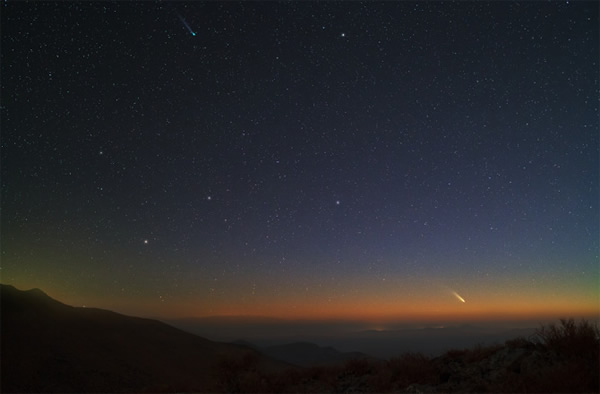Comet Invading Northern Skies
Two for one: Comet C/2012 F6 (Lemmon) (top) and Comet C/2011 L4 (PanSTARRS) (bottom right) as seen over the Atacama Desert in South America in this rare photograph featuring two comets in the sky at once.
It’s been a long time coming, but Comet Pan-STARRS will be visible in the northern hemisphere just after twilight beginning Thursday (March 7).
Discovered in June 2011 by the University of Hawaii’s Panoramic Survey Telescope and Rapid Response System, or Pan-STARRS, the comet has been dazzling sky-watchers in the southern hemisphere for weeks. It joins Comet Lemmon, also currently on display in the southern hemisphere.
Starting Thursday evening, it’s the northern hemisphere’s turn. To find the comet, look west just after sunset. It may be a little hard to see because of twilight and moonlight. Sky-watchers also will need an unobstructed, cloud-free view of the western horizon.
“Comet brightnesses are very hard to predict because it depends on many factors. For comets like Pan-STARRS, we don't know many of the physical properties, like the size of the nucleus or how active it will be. And when such a comet passes close to the sun, it can fragment,” astronomer Roy Gal, with the University of Hawaii, wrote in an email to Discovery News.
Astronomers say the best views may come on March 13, when the comet will be visible just below the sliver of a thin crescent moon. By the end of the month, Comet Pan-STARRS won’t be visible at all in the evening, but early birds can catch a glimpse of it in the eastern skies just before dawn. By then, the comet will be moving away from sun and Earth and so will appear fainter in the sky.
Comet Pan-STARRS made its closest approach to Earth on Tuesday, passing about 100 million miles away. It is expected to be visible to the naked eye, appearing about as bright as stars of the Big Dipper constellation. Binoculars or a small telescope may be need to view the comet’s distinctive tail.
Astronomers believe the comet, officially known as C/2011 L4, is making its first appearance in the inner solar system. Comets like these hail from the Oort Cloud, a cluster of frozen rocky, icy bodies that circle the sun about 50,000 times farther away than Earth's orbit. Occasionally, one body is gravitationally elbowed out of the cluster and begins a long, solo journey toward the sun.
As it approaches, ices in the comet vaporize, creating a bright envelope and gas and dust, called a coma, around the nucleus. The heating also generates two tails, each of which can span more than 1 million miles in length. One is made of dust and the other comprised of molecules that have been ionized by sunlight.
Pan-STARRS, which is due to make its closest approach to the sun on Sunday, is the first of two comets expected to pass by Earth this year.
In November, Comet ISON, discovered just this past September, should fly four times closer to the sun than Pan-STARRS. If Comet ISON survives the encounter, it could be as bright as the full moon and possibly even visible in the daytime skies.
“Comet ISON is a much bigger unknown. It gets much closer to the sun than Comet Pan-STARRS so it will get a lot more heating and thus a lot more activity -- and more chance of breaking apart,” Gal said.
“If it survives it's close passage by the sun, ISON could, for a short time, be visible in daytime. That would make it a ‘comet of the century.’ We usually see about one comet every 100 years that gets so bright,” he added.
Other recent celestial visitors include Comet McNaught and Comet 17P/Holmes in 2007 and Comet Hale-Bopp in 1997.
“Two bright comets in one year is a rare treat," Karl Battams, with the Naval Research Lab, said in an article posted on NASA’s website. "This could be good."
Mar 7, 2013 06:59 AM ET by Irene Klotz












